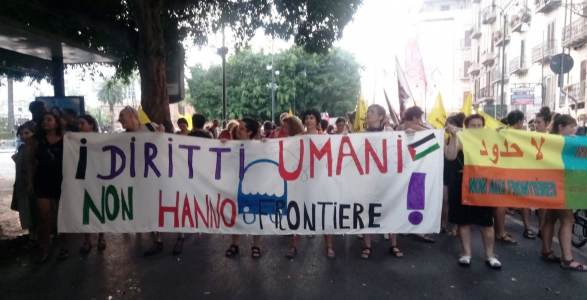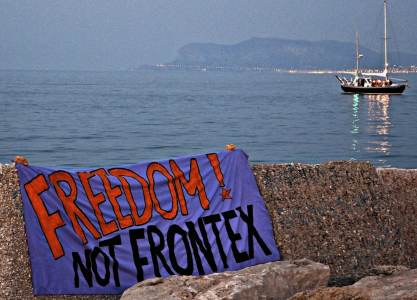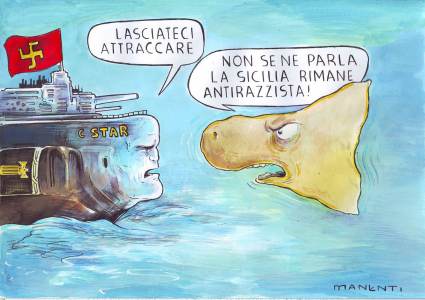Industries of the Italian Ministry of Defence to arm Libyan soldiers against migrants. The funds come from the EU
Article first published on December 14, 2021
Antoniomazzeoblog.blogspot.com – The Italian Ministry of Interior has a new partner for the Libyan Coast Guard’s education, training and rearmament programmes against migration: AID – Agenzia Industrie Difesa (Defence Industries Agency), the body that manages the Ministry of Defence’s factories and supplies the armed forces with military equipment. To sweeten the deal, some money and services will be entrusted to IOM, the United Nations International Organisation for Migration, in Libya.
With an administrative order dated October 20, 2021, the Central Directorate of Immigration and Border Police of the Ministry of Interior initiated the stipulation of a Cooperation Agreement with the Defence Industries Agency, within the framework of the “Support to Integrated Border and Migration Management in Libya – First and Second Phase” Project, co-financed by the European Union and the Italian Government (it kicked off on December 15, 2017). “The Ministry of the Interior, following meetings held on July 5 and September 23, 2021 with the Defence Industries Agency (AID), asked the latter to collaborate with initiatives in favour of non-EU countries to strengthen capacity in border and migration management in search and rescue at sea,” reads the Ministry of Interior’s resolution.
“Such collaboration is to be realized also through the supplying of means and materials to the benefit of the non-EU countries, in the broader framework of the peace and stabilization process for the maintenance of the international security (…). Considering the stipulation of a Cooperation Agreement as a necessity to regulate the relations between this Central Direction and the AID, and considering the electronic communications which have taken place to draw up the definitive text, Dr. Maria Gotti, Director of the General Affairs Office of the Direction of the Immigration has been appointed as responsible for the procedure”. In record time, the Ministry of the Interior -AID alliance was formalised the following day, i.e. October 21.
The Support to Integrated Border and Migration Management in Libya is one of the many projects that the European Union has funded to support Libya’s fragile and controversial institutions. The First Phase sees a direct EU contribution of € 42,223,927 through the Emergency Trust Fund for Africa established by the European Commission on October 20, 2015 “to address the root causes of illegal migration in Africa”. The implementation of the activities and the technical, logistical and administrative management of the project is entrusted to the Italian Ministry of the Interior, which has guaranteed a financial contribution of € 2,231,256.
“The Project aims to strengthen the capacities of the major Libyan authorities in border control, surveillance and management, in combating trafficking and smuggling of persons, in search and rescue at sea and in the desert,” reads the fact sheet prepared by the European Commission. “Among its main objectives are: the strengthening of Libyan entities responsible for maritime surveillance and SAR (search and rescue) operations and in combating irregular border crossings; the creation of basic infrastructure that will allow the Libyan Coast Guard to organise border surveillance activities in the best possible way; assistance in the definition and declaration of the SAR Region of Libyan competence with adequate operational procedures; the development of land border control activities in the desert, focusing on the areas of the southern borders that are highly affected by illegal crossings”.
With the addendum signed on December 18, 2020 by the European Commission and the Central Directorate for Immigration and Border Police, the purposes of the programme were expanded and its duration was extended to 84 months, i.e. until December 15, 2024. On December 22, 2020, Rome and Brussels also agreed on a second phase of the borders project in Libya, with an additional EU financial contribution of € 15 million. The factsheet of Support to Integrated Border and Migration Management in Libya – Phase II reports that “direct beneficiaries of the action will be a number of Libyan authorities: the Libyan Ministry of Interior through the General Administration for Coastal Security (GACS), the General Administration for the Security of Border Crossing Points (GASBCP) and the General Directorate for Combating Illegal Migration; the Ministry of Defence through the Land Border Guard and the Libyan Coast Guard and Port Security (LCGPS). Through the programme, the operational capacities of 5,000 Libyan government officials will be improved. Indirect beneficiaries will be migrants who will be rescued at sea through the provision of life-saving equipment and training of the Libyan Coast Guard and the General Administration for Coastal Security (GACS)”.
In the project fiche important elements are provided to fully understand the reasons and aims of the anti-immigration actions. “In the previous phase, the project intervention foresaw in particular the expansion of border management in the southern region and the purchase of naval units, fleet maintenance support and the establishment of a coastal radar network,” it states. “The need for this review emerged taking into consideration the very complicated situation in Libya due to the armed conflict that escalated in April 2019. The spread of the Covid-19 pandemic in early 2020 exacerbated the crisis. Given the deteriorating security environment in Libya that caused significant delays in the implementation of Phase 1 and after a consultation with the Italian Ministry of Interior, it was decided to reformulate the commitments in Phase II focusing on new actions in the area of stabilisation and response to Covid-19 (…) So far, technical crew training (including human rights training) has been carried out in favour of GACS staff and rubber boats have been provided. In addition, four boats have been repaired at a shipyard in Tunisia and are expected to be handed over to the GACS after the end of the lockdown imposed by Covid-19”.
Reproducing the mainstream narratives in Italy and Brussels, Phase 2 of the Border Management Project justifies support to the notorious Libyan Coast Guard with the need to “strengthen search and rescue operations and further reduce the number of people dying at sea”, while providing “a response to the migration crisis in the central Mediterranean in compliance with international law and human rights”. But what are the means and modalities of Italian and EU aid? The setting up and equipping of a “Mobile MRCC (Maritime Rescue Coordination Centre)”, the provision of “new SAR naval units” (no less than three) and “the implementation of joint activities of maintenance and repair of the units in Libya”.
“The Action also aims to support the alignment of the work of the Libyan Coast Guard and General Administration for Coastal Security in cooperation with other actors, such as the European Border and Coast Guard Agency (FRONTEX), the European Air and Sea Force EUNAVFORMED Irini, the United Nations High Commissioner for Human Rights (UNHCR), the International Organisation for Migration (IOM) and the International Centre for Migration Policy Development (ICMPD),” the project fiche adds. “In particular, complementarity will be ensured with the regional programme EU4Border Security through which FRONTEX contributes to strengthening border security in the southern neighbouring countries (budget of € 4 million) and with the activities funded under the Stability and Peace Plan to support conflict resolution, implement an agreement between the opposing parties and reinforce community-level outlets to reduce violence, especially in southern Libya.”
Finally, the fig leaf to sweeten the further accelerating blow to the rearmament of the Libyan armed forces and police and the militarisation of the migration response: “further cross-cutting objective of Phase II of the project is to improve the human rights conditions of migrants and refugees, especially for women and children, by seeking to ensure that the Libyan authorities direct their action in respect of human rights during SAR interceptions and during disembarkation procedures in cooperation with IOM and UNHCR.”
For this purpose, on April 7, 2021 the Directorate General of Immigration of the Ministry of Interior signed an agreement with the International Organization for Migration “for the implementation of activities under IOM’s competence in the framework of the project Support to Integrated Border and Migration Management in Libya“. “In the Addendum to the Agreement signed on December 18, 2020 between the European Commission and the Ministry of Interior, IOM was entrusted with Activity No. 6 consisting in strengthening humanitarian management and health, border and mobility management capacities by the authorities of Southern Libya and the same Organisation was qualified as Co-Delegate of the project”, explain the Interior officials.
Last October 15 the outcome of the public tender was published, awarded by the Directorate-General for Immigration to the IOM (subsequently amended on November 3) to carry out pro-human rights interventions with migrants and refugees in Libya. The international institution was awarded funding worth a total of € 12,692,831. But the biggest surprise was the contracting authority named for the contract: AID – Agenzia Italiana Difesa (Italian Defence Agency), i.e. the public body created to manage the activities of the military establishments under direct control of the Ministry of Defence and whose headquarters are in Rome in the Palazzo della Marina, the headquarters of the Staff of the Navy. In other words, as of today, it is the Defence industries that coordinate the training and supply of equipment to Libyan anti-migrant units, with a watchful eye on part of the actions and expenditure of the IOM in Libya.
“The main activities carried out by AID (Italian Defence Agency) include the demilitarisation of ammunition, the production of small-calibre ammunition and cartridges, the maintenance of naval and land units and weapon systems, the production of drugs, antidotes and gunpowder, and shipbuilding,” says the Agency’s website. “The activity of enhancing the value of armament material, in particular land, air, sea and light weapons, represents a strategic asset. In addition to representing an important source of revenue and cash flow for AID, the transfer of these materials allows the recovery of important resources for the Armed Forces to be reinvested in the entire defence system. The constant dialogue with the Armed Forces and other Armed Forces of the State, as well as with Armed Forces of foreign countries and companies in the defence sector, allows the creation of a scenario in which the possibilities of business development are realized”.
There is a long list of companies producing death systems with which AID has started collaborations in the research and production sector: among them Leonardo S.p.A., Beretta, Fiocchi, SIMMEL Difesa, Magnaghi and MBDA. Since the appointment of former PD senator Nicola Latorre as general director, the Agency has entered into framework agreements with Fincantieri S.p.A. (to expand the activities of the Castellammare di Stabia Military Establishment and develop naval outfitting), with IVECO Defence Vehicles (joint use of the Torre Annunziata Military Spolette Establishment) and with Intermarine S.p.A. of the Colaninno family (construction of fast boats and hydrofoils).
AID is also establishing itself as an important national player in the marketing and import-export of weapon systems. As documented by a study published in September 2020 by researchers Giorgio Beretta and Carlo Tombola of the Permanent Observatory on Light Weapons and Security and Defence Policies (OPAL), in the five-year period 2014-2019 the Agency carried out export transactions for about € 27 million, compared to € 9 million for imports, half of which in 2019 alone. In particular, large quantities of armaments “considered obsolete” were sold, including 207 SIDAM self-propelled artillery to Belgium; 206 M-113 and 24 VCC “Camillino” tanks; 26 Sikorsky HH-3F “Pelican” helicopters.
“Alongside more or less efficient equipment, large quantities of spare parts were also disposed of, sometimes entire warehouses, which also involved separate authorisations,” write Giorgio Beretta and Carlo Tombola. “Two of these alone accounted for a total value of about € 4.6 million: about 7 million parts for Leopard 1A5 in 2018 to Greece for € 1.8 million; 17 million parts for M-113 tanks and M109L self-propelled vehicles in 2015 to Pakistan for € 2.8 million.”
Also relevant are the authorisations to export to Malta (in 2017 Browning 12.7 and coaxial 42/59 machine guns and Beretta 92SL pistols) and the disposal of large quantities of ammunition of different calibre and type (500,000 pieces in 2019 to France and 420,000 in 2015); M107 155mm grenades (40,000 pieces in 2016, probably sold to Croatia); 110 Milan missiles (in 2015 to Estonia and in 2018 to France); components of the “Hawk” and “TOW” missile systems.
With a curriculum of these characteristics and proportions it is predictable to imagine what the contribution of AID will be as a partner of the Ministry of the Interior in the next stages of the Libyan border control support project: the acquisition and supply of additional naval and land means for the police forces in Tripoli. On the Agency’s website there is already a good list of boats and systems ‘decommissioned’ by the Guardia di Finanza (Finance Police), the State Police and the Carabinieri that would fit in perfectly with the raids of the Tripoli Coast Guard in the Mediterranean: M.S.F. outboard fiberglass motor boats; 600 class coastguard units; V. 5800 offshore boats “for navigation in all weather conditions”; Intermarine’s 6000 class fast patrol boats; small V.A.I. 200 and V.A.I. 500 lookouts; 5000 class patrol boats with speeds of over 54 knots; G.L. 1400 coastal patrol boats; Shark class cabin cruisers; Crestitalia class lookouts; jet skis; fibreglass “Blob 50” inflatable boats; 800 class SAR units; etc, etc.
AID also has several land vehicles on offer, in particular the Land Rover “Defender” (already used by the Carabinieri), the “Defender 90 Soft Top” and the ACM 80/90 Light Off Road Truck (already used by the Italian Army). The (European) money is there, and so is the (Italian) will to arm the Libyan units. We are waiting to see what the next anti-migrant “gifts” will be.
Antonio Mazzeo
Translated from Italian by Francesca Cavallo






